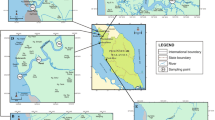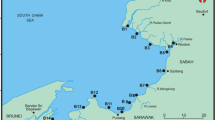Abstract
Due to directly receiving high volume of untreated urban and industrial sewage and in turn transferring the pollutants to fish and back to humans, the International Anzali Wetland has been considered to be urgently registered in the Montreux Record. Hence, the present study was aimed to determine the spatial distribution of the linear alkylbenzenes (LABs) in surface sediments of the wetland and its sewage contamination situation. The surface sediments (sampling stations = 167) were collected from the western, eastern, southwest, and central regions of the wetland. The samples were extracted, fractioned, and then analyzed using gas chromatography–mass spectrometry (GC-MS). The concentration of LABs in the sediment samples revealed a range from 394.12 to 109,305.26 ng g−1 dw. The concentrations of ΣLABs in the eastern region were significantly higher than that in the other regions. The occurrence of low ratio of internal to external isomers (I/E ratio) of LABs (from 0.65 to 1.30) and D% (from − 0.07 to 24.13) implied effluent row or poorly untreated sewage into the wetland. No correlation was observed between the detected LAB concentrations with total organic carbon (TOC) and grain size. Taken together, regional anthropogenic inputs are the controlling factors for the observed spatial distributions of ∑LABs in the International Anzali Wetland. The findings suggested that LABs are powerful indicators to trace anthropogenic sewage contamination and also highlighted the necessity of sewage treatment plants to be founded around the International Anzali Wetland, especially in the vicinity of the eastern and central regions.










Similar content being viewed by others
Change history
30 January 2021
A Correction to this paper has been published: https://doi.org/10.1007/s11356-020-11967-7
References
Alkhadher SAA, Zakaria MP, Yusoff FM, Kannan N, Suratman S, Keshavarzifard M, Magam SM, Masood N, Vaezzadeh V, Sani MSA (2015) Baseline distribution and sources of linear alkyl benzenes (LABs) in surface sediments from Brunei Bay, Brunei. Mar Pollut Bull 101:397–403
Chalaux N, Takada H, Bayona JM (1995) Molecular markers in Tokyo Bay sediments: sources and distribution. Mar Environ Res 40:77–92
Dauner ALL, Hernández EA, MacCormack WP, Martins CC (2015) Molecular characterisation of anthropogenic sources of sedimentary organic matter from Potter Cove, King George Island, Antarctica. Sci Total Environ 502:408–416
Dean WE (1974) Detemination of carbonate and organic matter in calcareous sediments and sedimentary rocks by loss on ignition: comparison with other methods. J Sedimentary Res 44:242–248
Díez S, Jover E, Albaigés J, Bayona JM (2006) Occurrence and degradation of butyltins and wastewater marker compounds in sediments from Barcelona harbor, Spain. Environ Int 32:858–865
Evans MI (1994) Important bird areas in the Middle East, 2. Birdlife international, Cambridge
Gustafsson Ö, Long CM, MacFarlane J, Gschwend PM (2001) Fate of linear alkylbenzenes released to the coastal environment near Boston Harbor. Environ Sci Technol 35:2040–2048
Hartmann PC, Quinn JG, King JW, Tsutsumi S, Takada H (2000) Intercalibration of LABs in marine sediment SRM1941a and their application as a molecular marker in Narragansett Bay sediments. Environ Sci Technol 34:900–906
Hassanzadeh N, Sari AE, Khodabandeh S, Bahramifar N (2014) Occurrence and distribution of two phthalate esters in the sediments of the Anzali Wetlands on the coast of the Caspian Sea (Iran). Mar Pollut Bull 89:128–135
Hong H, Xu L, Zhang L, Chen JC, Wong YS, Wan TSM (1995) Special guest paper. Mar Pollut Bull 31(4–12):229–236
Islam MS, Tanaka M (2004) Impacts of pollution on coastal and marine ecosystems including coastal and marine fisheries and approach for management: a review and synthesis. Mar Pollut Bull 48:624–649
Isobe KO, Zakaria MP, Chiem NH, Minh LY, Prudente M, Boonyatumanond R, Saha M, Sarkar S, Takada H (2004) Distribution of linear alkylbenzenes (LABs) in riverine and coastal environments in south and Southeast Asia. Water Res 38:2449–2459
Koike T, Koike H, Kurumisawa R, Ito M, Sakurai S, Togo A, Saha M, Arifin Z, Takada H (2012) Distribution, source identification, and historical trends of organic micropollutants in coastal sediment in Jakarta Bay, Indonesia. J Hazard Mater 217:208–216
Liu LY, Wang JZ, Wong CS, Qiu JW, Zeng EY (2013) Application of multiple geochemical markers to investigate organic pollution in a dynamic coastal zone. Environ Toxicol Chem 32:312–319
Long ER, Robertson A, Wolfe DA, Hameedi J, Sloane GM (1996) Estimates of the spatial extent of sediment toxicity in major US estuaries. Environ Sci Technol 30(12):3585–3592
Luo X-J, Chen S-J, Ni H-G, Yu M, Mai B-X (2008) Tracing sewage pollution in the Pearl River Delta and its adjacent coastal area of South China Sea using linear alkylbenzenes (LABs). Mar Pollut Bull 56:158–162
Macıas-Zamora J, Ramırez-Alvarez N (2004) Tracing sewage pollution using linear alkylbenzenes (LABs) in surface sediments at the south end of the Southern California bight. Environ Pollut 130:229–238
Magam SM, Zakaria MP, Halimoon N, Aris AZ, Kannan N, Masood N, Mustafa S, Alkhadher S, Keshavarzifard M, Vaezzadeh V (2016) Evaluation of distribution and sources of sewage molecular marker (LABs) in selected rivers and estuaries of peninsular Malaysia. Environ Sci Pollut Res 23:5693–5704
Martins CC, Ferreira JA, Taniguchi S, Mahiques MM, Bícego MC, Montone RC (2008) Spatial distribution of sedimentary linear alkylbenzenes and faecal steroids of Santos Bay and adjoining continental shelf, SW Atlantic, Brazil: origin and fate of sewage contamination in the shallow coastal environment. Mar Pollut Bull 56:1359–1363
Martins CC, Bicego MC, Mahiques MM, Figueira RC, Tessler MG, Montone RC (2010) Depositional history of sedimentary linear alkylbenzenes (LABs) in a large south American industrial coastal area (Santos estuary, southeastern Brazil). Environ Pollut 158:3355–3364
Martins CC, Aguiar SN, Bícego MC, Montone RC (2012) Sewage organic markers in surface sediments around the Brazilian Antarctic station: results from the 2009/10 austral summer and historical tendencies. Mar Pollut Bull 64:2867–2870
Martins CC, Cabral AC, Barbosa-Cintra SC, Dauner ALL, Souza FM (2014) An integrated evaluation of molecular marker indices and linear alkylbenzenes (LABs) to measure sewage input in a subtropical estuary (Babitonga Bay, Brazil). Environ Pollut 188:71–80
Masood N, Zakaria MP, Halimoon N, Aris AZ, Magam SM, Kannan N, Mustafa S, Ali MM, Keshavarzifard M, Vaezzadeh V (2016) Anthropogenic waste indicators (AWIs), particularly PAHs and LABs, in Malaysian sediments: application of aquatic environment for identifying anthropogenic pollution. Mar Pollut Bull 102:160–175
Medeiros PM, Bıcego MC (2004) Investigation of natural and anthropogenic hydrocarbon inputs in sediments using geochemical markers. I. Santos, SP––Brazil. Mar Pollut Bull 49:761–769
Mortazavi S, Bakhtiari AR, Sari AE, Bahramifar N, Rahbarizade F (2012) Phenolic endocrine disrupting chemicals (EDCs) in Anzali Wetland, Iran: elevated concentrations of 4-nonylphenol, octhylphenol and bisphenol A. Mar Pollut Bull 64:1067–1073
Ni H-G, Lu F-H, Wang J-Z, Guan Y-F, Luo X-L, Zeng EY (2008) Linear alkylbenzenes in riverine runoff of the Pearl River Delta (China) and their application as anthropogenic molecular markers in coastal environments. Environ Pollut 154:348–355
Phillips CR, Venkatesan MI, Lin T (2001) Linear alkylbenzenes in muscle tissues of white croaker near a large ocean outfall in southern California, USA. Environ Toxicol Chem 20:231–238
Raymundo C, Preston M (1992) the distribution of linear alkylbenzenes in coastal and estuarine sediments of the western North Sea. Mar Pollut Bull 24:138–146
Rezaitabar S, Sari AE, Bahramifar N, Ramezanpour Z (2017) Transfer, tissue distribution and bioaccumulation of microcystin LR in the phytoplanktivorous and carnivorous fish in Anzali Wetland, with potential health risks to humans. Sci Total Environ 575:1130–1138
Rinawati R, Koike T, Koike H, Kurumisawa R, Ito M, Sakurai S, Togo A, Saha M, Arifin Z, Takada H (2012) Distribution, source identification, and historical trends of organic micropollutants in coastal sediment in Jakarta Bay, Indonesia. J Hazard Mater 217–218:208–216
Sajedipour S, Zarei H, Oryan S (2017) Estimation of environmental water requirements via an ecological approach: a case study of Bakhtegan Lake, Iran. Ecol Eng 100:246–255
Santisteban JI, Mediavilla R, Lopez-Pamo E, Dabrio CJ, Zapata MBR, Garcia MJG, Castano S, Martínez-Alfaro PE (2004) Loss on ignition: a qualitative or quantitative method for organic matter and carbonate mineral content in sediments. J Paleolimnology 32:287–299
Takada H, Ishiwatari R (1987) Linear alkylbenzenes in urban riverine environments in Tokyo: distribution, source, and behavior. Environ Sci Technol 21:875–883
Takada H, Ishiwatari R (1990) Biodegradation experiments of linear alkylbenzenes (LABs): isomeric composition of C12 LABs as an indicator of the degree of LAB degradation in the aquatic environment. Environ Sci Technol 24(1):86–91
Takada H, Ishiwatari R, Ogura N (1992) Distribution of linear alkylbenzenes (LABs) and linear alkylbenzenesulphonates (LAS) in Tokyo Bay sediments. Estuar Coast Shelf Sci 35:141–156
Vaezzadeh V, Pauzi Zakaria M, Tan Shau-Hwai A, Zaiton Ibrahim Z, Mustafa S, Keshavarzifard M, Mohsen Magam S, Abdullah Abdo Alkhadher S (2015) Source type evaluation of polycyclic aromatic hydrocarbons (PAHs) in surface sediments from the Muar River and Pulau Merambong, peninsular Malaysia. Environ Forensic 16:135–142
Vails M, Bayona JM, Albaiges J (1990) Broad spectrum analysis of ionic and non-ionic organic contaminants in urban waste water and coastal receiving aquatic systems. Int J Environ Anal Chem 39:329–348
Venkatesan M, Merino O, Baek J, Northrup T, Sheng Y, Shisko J (2010) Trace organic contaminants and their sources in surface sediments of Santa Monica Bay, California, USA. Mar Environ Res 69:350–362
Veres D (2002) A Comparative Study Between Loss on Ignition and Total Carbon Analysis on Mineralogenic Sediments. Studia Universitatis Babes-Bolyai. Geologia 47(1):171–182
Wang J-Z, Zhang K, Liang B (2012) Tracing urban sewage pollution in Chaohu Lake (China) using linear alkylbenzenes (LABs) as a molecular marker. Sci Total Environ 414:356–363
Wei G-L, Bao L-J, Guo L-C, He Z-C, Wu F-C, Zeng EY (2014) Utility of soil linear alkylbenzenes to assess regional anthropogenic influences with special reference to atmospheric transport. Sci Total Environ 487:528–536
Yancheshmeh RA, Bakhtiari AR, Mortazavi S, Savabieasfahani M (2014) Sediment PAH: contrasting levels in the Caspian Sea and Anzali Wetland. Mar Pollut Bull 84:391–400
Zhang K, Wang JZ, Liang B, Shen RL, Zeng EY (2012) Assessment of aquatic wastewater pollution in a highly industrialized zone with sediment linear alkylbenzenes. Environ Toxicol Chem 31:724–730
Acknowledgements
The authors would like to thank Ana Lúcia L. Dauner and César C. Martins from Centro de Estudos do Mar da Universidade Federal do Paraná, Pontal do Paraná, PR, Brazil, for their constructive comments and Manzar Haghdoust, Hamed Tavakoli, Mohammad Masoudnik, Eshagh Khaki, and Zahra Nasr from the Faculty of Natural Resources and Marine Sciences, Tarbiat Modares University, for their kind assistance in sample preparation. Last but not the least; thanks to Hamid Salari Joo (h.salary1365@gmail.com) for his academic English language editing skills during the preparation of the manuscript.
Author information
Authors and Affiliations
Corresponding author
Additional information
Responsible editor: Hongwen Sun
Electronic supplementary material
ESM 1
(DOCX 996 kb)
Rights and permissions
About this article
Cite this article
Bakhtiari, A.R., Javedankherad, I., Mohammadi, J. et al. Distribution of linear alkylbenzenes as a domestic sewage molecular marker in surface sediments of International Anzali Wetland in the southwest of the Caspian Sea, Iran. Environ Sci Pollut Res 25, 20920–20929 (2018). https://doi.org/10.1007/s11356-018-1942-1
Received:
Accepted:
Published:
Issue Date:
DOI: https://doi.org/10.1007/s11356-018-1942-1




